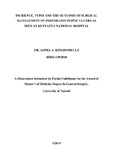| dc.description.abstract | BACKGROUND:
Perforated Peptic Ulcer disease (PPUD) is believed to be less common and less severe as the
result of modern medical treatment of peptic ulcer disease (PUD). Management of PUD has
improved over the past few decades; however the widespread usage of non-steroidal antiinflammatory
drugs (NSAIDs) means that the burden of PUD and PPUD remains relevant
issue. In the past several decades the pharmacologic and endoscopic treatment of PUD had
shown dramatic improvement, however perforated peptic ulcers (PPUs) have been observed
to be the leading cause of generalized peritonitis and hence their management have continue
to be a challenging task in our environment. Literature reviews from western countries
indicate that there are increasing rates of perforated PU in chronically ill and elderly patients
unlike our local observationsin younger patients. Further literature reviews demonstrate that
delayed treatment after peptic ulcer perforations increase complication rates, prolonged
hospital stay as well as mortality. Complications following ulcer perforations are associated
with delayed presentation, surgical techniques, immune status of the patients, and others;
however, the incidence and complications associated with the size of perforations has been
scarcely discussed in our set up.
OBJECTIVE: The aim of this study is to determine the incidence, types and the outcome of
surgical management of perforatedpeptic ulcers as seen at Kenyatta National Hospital.
METHODS: 9 months prospective Descriptive cross-sectional hospital based study carried
out at Kenyatta National Hospital (KNH) Casualty, Theatre and the General surgery wards.
All patients who presented with clinical features of perforated PUD, those who agreed and
had signed informed consent, and intraoperative were found to have perforation were
recruited for the study. Data collected through structured questionnaires, analysis of the
variables i.e. the incidence, types of perforation in terms of anatomical location and the size,
surgicaltechnique used and its outcome were done using the statistical program for social
sciences (SPSS) version 13. Data presented in form of graphs, tables and pie charts.
RESULTS: All 22 cases recruited were males with age ranging from 22 to 76 years. Most of
the cases, 45%, were operated within the first 24hrs after the onset of severe acute symptoms
of abdominal pain, 27% within 48hrs, 14% within 72hrs, and 14% were operated >72hrs after
the onset of severe symptoms of abdominal pain. The incidence of perforated peptic ulcer
was found to be 19 per 1000years. Common site of perforation was at first part of duodenum
xiii
64% with small perforation (<1cm) 36% and large perforations (1 - 3cm) 64%. All cases
underwent upper midline laparotomy and repair was done using Graham’s omental patch.
The outcome was 62% of all cases had no complications while 19% had surgical site
infection, 10% intraabdominal abscess, 5% wound dehiscence and 5% leaking. 50% were
discharged home within the first week post surgery, 31.82% on second week 4.54% on third
week and 9.08% on fourth week. Mortality was 4.54%.
In this study all perforations were found to be anterior perforations predominant duodenal
perforations with large perforation size. Graham’s omental patch remained the main surgical
procedure in all cases.
CONCLUSION: The earlier the presentation of the patient to the hospital resulted in good
outcome. The small and large perforations are easily repaired by Graham’s omental patch. | en_US |
| dc.description.department | a
Department of Psychiatry, University of Nairobi, ; bDepartment of Mental Health, School of Medicine,
Moi University, Eldoret, Kenya | |



